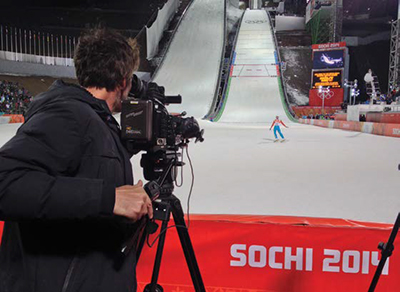NBC Takes Olympic Workflow Mainstream

SOCHI, RUSSIA—The XXII Winter Olympics were at once one of the hardest Olympics NBC’s team has done, and one of the smoothest.
The well-documented construction and other delays made the run up to the Feb. 7 start difficult, a situation softened by building extra time into the schedule, getting through customs a little earlier, and so on.
“It was really hard getting to Opening Ceremony,” said David Mazza, senior vice president and chief technology officer at NBC Sports Group and NBC Olympics. “But from Opening Ceremony onward, it’s probably been one of the smoother games.”
Mazza said that once the competitions began, everybody just started doing what they normally do. “That’s where you saw the professionalism in the veterans shine,” he said. “Once they had the right tools in the right place, you turn the lights down and go on the air, they’re doing their jobs.”
Sochi, more than any other Olympic host city, was built from the ground up, added Mazza: “There’s never been an Olympics that was built so much from zero… the Russians got it done.”
THE RIGHT TOOL, THE RIGHT PLACE
Having the right people in the right place is more than half of the equation. In Sochi, more than ever before, NBC Olympics also had the right tool in place. The broadcaster’s media asset management workflow—developed across six Olympics as technologies and compatibilities came online—went mainstream.
Sochi was the eighth stop in NBC’s 11th consecutive Olympic Games road show (the network has secured the broadcast rights to the Olympics up to and including 2020), and it was a major milestone in the network’s decade-plus march toward true file-based production, shared across sites. For the first time, users at key venues, the International Broadcast Center, or based in the United States, could all “remote” the broadcaster’s archive that resides within the new NBC Sports facility in Stamford, Conn.
Get the TV Tech Newsletter
The professional video industry's #1 source for news, trends and product and tech information. Sign up below.
In Sochi, NBC’s commitment to, and confidence in its MAM system reached a level where the traditional “record wall” of tape or optical disc machines in a sector of the IBC that had been called “Central Videotape” for decades, was abandoned. Although the recording format has not changed since Vancouver, the record devices are now eight 4-channel Harmonic MediaDecks.
Called simply “the MAM” by most, the system constitutes the central part of a collaborative production workflow involving best-of-breed servers from EVS, Avid, and Harmonic, coupled with crucial software and hardware from smaller vendors.
Most editing duties were handled by 45 Avid Media Composer edit seats, aided by Avid ISIS storage and Interplay. File-based movement was handled by NBC’s Avid media asset management system, ingesting video from 40 channels of Harmonic MediaDecks, plus 300 TB MediaGrid storage pools located in Sochi and Stamford. All truck replays and live playback video were recorded using more than 60 EVS XT2 and (mostly) XT3 HD video servers.

John Biggins, a DP for NBC Olympics, at one of the Alpine events. The workflow and design was very similar to the one NBC deployed in London in 2012, but venue connectivity took a big step forward in Sochi. “For the first time, our production staff are not only pushing [EVS] IP Director database EDLs and clips to the MAM, they’re also pushing to key venues,” said Darryl Jefferson, vice president of Digital Workflow for NBC Olympics.
Sochi saw NBC taking a leap of faith. “For the past year we’re operating this way in Stamford, and we realized it was possible to run this way for the Olympics as well,” said Matt Green, senior digital media engineer for NBC Sports Group and NBC Olympics. “In London we left ourselves a safety net by building off Sony’s XDCAM [optical disc] stations. If we lost automation, if we lost asset management, if we lost central storage, we could put everything on optical discs as we had done in Vancouver and Beijing.”
Although the entire system continues to be based on Sony’s Long-GOP 50 recording format, not having handheld media in a production process can be a hurdle for some users. But as adoption rates exceeded expectations, the benefits became obvious to end users, according to Jefferson. “The thing that’s remarkable to us as stewards and watchers of the project is that as soon as people can access the entire library, there’s really no way to put that genie back in the bottle,” he said.
“Even though we turned the MAM on to the broadcast clients for the first time in London, this is the first time it reached out to enough places that you really saw the impact on the organization,” Mazza said. “The venues, New York City, Florida, Telemundo... they were all connected. So I would say this is really where the MAM sort of went mainstream, front and center.”
SPLIT PRODUCTION AND MORE
Pushing the MAM to key venues was a big difference from London to Sochi. Another key difference was the heavy use of the NBC Sports facility in Stamford, which became operational several months after the London Olympics, but a full year before Sochi.
Although the facility houses numerous NBC Sports divisions, it was designed with Olympics in mind. A substantial part of the facility can switch back and forth between 50 and 60 Hz reference and three of the control rooms and two-thirds of the EVS rooms and the edit systems in Stamford were running at 50 Hz. Conversion to 60 Hz was generally done at the very end of production.
“That saved us a lot of conversion,” Mazza said. “For example, curling has six or seven feeds going from Sochi to the curling control room in Stamford at 50 Hz, and it had two converters on its output, and as a backup. So that saved five converters, just in that one instance.”
It also helped out during the Opening and Closing Ceremonies, in which 30 Rock (not set up for 50 Hz) took a backup feed that had passed through Stamford for conversion.
Stamford is very well connected to both the NOC in New Jersey, and 30 Rock. “It’s now a place where we can send our own material and do things to it, and then send it off to another NBC entity,” said Mazza. “We’ve kind of ‘normalized’ it in Stamford.”

